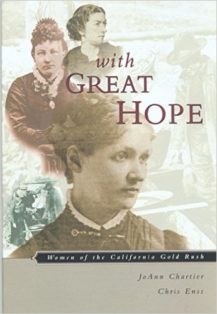They came to California with great hope for the future-they left a legacy.
Enter to win a copy of
With Great Hope: Women of the California Gold Rush.

The discovery of gold at Sutter’s Mill, California, in 1848 set off a siren call that many Americans couldn’t resist. Enthusiastic pioneers headed west intent on picking up a fortune in the nearest stream. Though only a few actually used a pickax in the search for a fortune, women played a major role in the California Gold Rush. They discovered wealth working as cooks, writers, photographers, performers, or lobbyists. Some even realized dreams greater than gold in the western land of opportunity and others experienced unspeakable tragedy.
If Mary Graves had stayed in Indiana where she was born on November 1, 1826, she might have married the boy next door, taught students to read and write at a school house in her hometown, and lived out her days watching her children and grandchildren grow up on the family farm. Her life, however, took a different course when her family joined the Donner Party in 1846 and headed west.
Mary was nineteen when her father, Franklin, made the decision to move his family to California. The wagon train the Graves joined was organized by George and Jacob Donner and James Reed and their families. The initial group set out from Springfield, Illinois in April and was joined by additional members when it reached Independence, Missouri. Franklin and Elizabeth Graves and their nine children joined the Donner Party in August at Fort Bridger, Wyoming, with their belongings piled in three large wagons.
Mary was excited about the journey. She had no doubt heard stories of the golden land of opportunity and couldn’t wait to see its riches for herself. She knew her family might experience difficulties getting there but that had not put a damper on her gleeful spirit. She didn’t care that the trail was treacherous, and she wasn’t afraid of the Indians that guarded the way. She placed all her faith in God and her father to get her and her family to their new home safely.
Historical records note that Mary was a beautiful young lady with dark eyes and long, wavy black hair. She carried her slender, five-foot, seven-inch frame with grace. Her complexion was creamy olive. She captured the attention of many of the twenty-two single men in the party, but she was engaged to John Synder, the driver of one of her father’s teams.
On October 5, 1846, John Synder and Milton Elliott, another driver exchanged heated words over whose team of oxen could pull a load raced each other to the top of the hill. John’s and Milton’s teams got tangled up as they raced each other to the top of the hill. John was furious and started cussing at Milton and beating his livestock with a whip-stock. James Reed stepped in and tried to calm him down. John thought James was threatening him, and he jumped off his wagon and beat James over the head with the butt end of his heavy whip-stock while Mary looked on. When James Reed managed to stand up and wipe the blood from his eyes, his wife ran over to help him, and John hit her over the head too. James quickly pulled out a knife and stabbed John. Mary’s intended died fifteen minutes later. The stunned onlookers were outraged. They wanted to hang James. Mary was asked to sit in judgment of him, but she refused. James was banished from the group.
The gleam in Mary’s eyes had started to fade. The journey west was grueling. In addition to having battled the heat and rough terrain, the party had taken a “shortcut” to California that actually took them several hundred miles out of their way. Lack of water and a variety of petty arguments, like the one between John, Milton, and James, created strife among the party members. Their food was running low and many of their oxen and horses had been stolen by Indians.
Mary and the others finally reached the Sierra Nevada mountains on October 28th, 1856.
To learn more about Mary Graves and the other women who came to the Gold Country with great hope read
With Great Hope: Women of the California Gold Rush.

